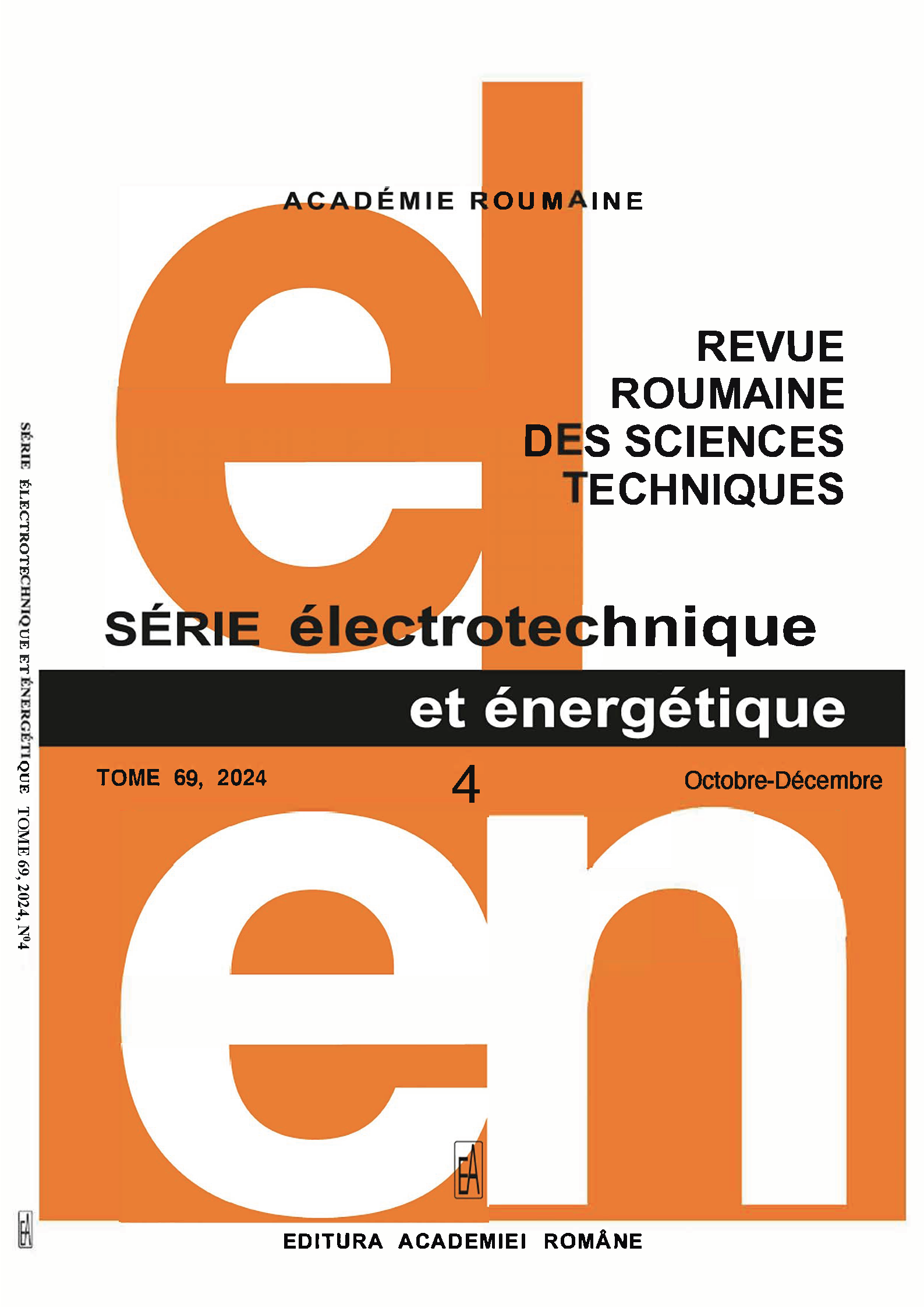DEMONSTRATING THE SYMMETRY AND NON-SYMMETRY COMPONENTS BALANCE IN GRIDS WITH NEUTRAL CONDUCTOR
DOI:
https://doi.org/10.59277/RRST-EE.2024.69.4.4Keywords:
Distribution grid, Active power, Reactive power, Unbalanced consumers, Nonlinear consumers, Țugulea power theory, Powers of symmetry, Powers of non-symmetry, Residual (distorting) powers, Waveforms, Harmonics, Total harmonic distortion (THD)Abstract
In the context of the ever-increasing complexity of modern power systems, optimizing consumers’ performance to improve electrical energy quality becomes paramount. This article thoroughly examines the power transfer effects in the context of distorting and non-symmetrical regimes in three-phase, four-wire power systems, focusing on heavily nonlinear and unbalanced consumer influence across the grid. Particular emphasis is placed on the impact of these regimes on the parasitic active and reactive powers affecting linear and balanced consumers due to distorting and unbalanced ones. An essential aspect of this analysis is including the neutral conductor in the experimental circuit, enhancing relevance and a more profound understanding of consumer interactions in modern networks. Quantitative aspects of the phenomena involved are assessed from the perspective offered by SCPT (introduced by Andrei Ţugulea), allowing us to identify the source of non-symmetry and residual powers through comprehensive power balance equations for the active and reactive powers.
References
(1) R. Thankakan, E.-R.-S. Nadar, A novel DC-DC converter fed by PV source employing improved incremental conductance algorithm under partial shadow conditions, Rev. Roum. Sci. Techn.–Électrotechn. et Énerg., 67, 2, pp. 145–150 (2022).
(2) K. Benmouiza, Nonlinear clustered adaptive-network-based fuzzy inference system model for hourly solar irradiation estimation, Rev. Roum. Sci. Techn.–Électrotechn. et Énerg., 68, 1, pp. 7–11 (2023).
(3) K. Guerraiche, F. Midouni, N. El. Sahraoui, L. Dekhici, Impact de la generation distribuée sur la coordination des relais directionnels (Impact of distributed generation on the coordination of directional relays), U.P.B. Sci. Bull., Series C, 85, 1, pp. 275–290 (2023).
(4) F. Amrane, A. Chaiba, B. François, Improved adaptive nonlinear control for variable speed wind-turbine fed by direct matrix converter, Rev. Roum. Sci. Techn.–Électrotechn. et Énerg., 68, 1, pp. 58–64 (2023).
(5) S. Ye, F. Xu, M. Lin, Y. Li, Optimal scheduling of integrated energy systems based on mixed integer linear programming with flexible load accounting, U.P.B. Sci. Bull., Series C, 85, 2, pp. 331– 348 (2023).
(6) G. Shahgholian, S. M. A. Zanjani, A study of voltage sag in distribution system and evaluation of the effect of wind farm equipped with doubly-fed induction generator, Rev. Roum. Sci. Techn.–Électrotechn. et Énerg., 68, 3, pp. 271–276 (2023).
(7) Y. Benyssaad, Nouveau modèle d'optimisation basé sur la ‘maintenance axée sur la fiabilité’des réseaux de distribution électrique (A new optimization model based on ‘reliability centered maintenance’ of electrical distribution network), Rev. Roum. Sci. Techn.–Électrotechn. et Énerg., 67, 1, pp. 27–32 (2022).
(8) J. Chen, K. Liu, L. Du, Dynamic error analysis of smart electricity meter under complex fluctuating load, U.P.B. Sci. Bull., Series C, 85, 3, pp. 433– 445 (2023).
(9) N. Zidane, S. Lalouni Belaid, A new fuzzy logic solution for energy management of hybrid photovoltaic/battery/hydrogen system, Rev. Roum. Sci. Techn.–Électrotechn. et Énerg., 67, 1, pp. 21–26 (2022).
(10) A. Abbadi, F. Hamidia, Y. Chiba, Adaptive non-linear voltage controller based multivariable sliding mode extremum seeking approach applied to multi-machine power system, Rev. Roum. Sci. Techn.– Électrotechn. et Énerg., 67, 1, pp. 65–72 (2022).
(11) A. Ţugulea, Considerations on the energy effects of distorting regimes (in Romanian), Energetica, XXXIV, 1, pp. 27–31 (1986).
(12) A. Ţugulea, Considerations regarding energy effects in the non-symmetrical harmonic regimes of three-phase networks (in Romanian), Energetica, XXXIV, 3, pp. 121–130 (1986).
(13) A. Ţugulea, C. Golovanov, The energy effects of non-symmetrical and distorting regimes of electric power systems. Measurement possibilities, ENERG, 3, pp. 130–159,1987.
(14) A. Ţugulea, Power flows under non-sinusoidal and non-symmetric periodic and almost periodic steady states of electrical power system, Proc. of 6th Int. Conf. On Harmonics in Power Systems (ICHPS VI), Bologna, Italy, pp. 388–395 (1994).
(15) A. Ţugulea, Criteria for the definition of the electric power quality and its measurement systems, European Transactions on Electrical Power, 6, 5, pp. 357–363 (1996).
(16) R. M. Ciuceanu, I. V. Nemoianu, V. Mănescu (Păltânea), G. Păltânea, On Professor Ţugulea’s visionary power theory: a review, recent advances and perspectives, Roum. Sci. Techn. – Électrotechn. et Énerg., 63, 2, pp. 123–127 (2018).
(17) I. V. Nemoianu, R. M. Ciuceanu, Non-symmetry and residual active and reactive powers flow in non-linear three-phase unbalanced circuits, Roum. Sci. Techn. – Électrotechn. et Énerg., 60, 2, pp. 227–237 (2015).
(18) I. V. Nemoianu, R. M. Ciuceanu, Characterization of non-linear three-phase unbalanced circuits powers flow supplied with symmetrical voltages, Roum. Sci. Techn. – Électrotechn. et Énerg., 60, 3, pp. 355–365 (2015).
(19) I. M. Mîndreanu, R. M. Ciuceanu, I. V. Nemoianu, Experimental assessment of consumer unbalance and nonlinearity effects in three-phase networks without neutral conductor, Roum. Sci. Techn. – Électrotechn. et Énerg., 69, 3, pp. 287–292 (2024).
(20) B. D. H. Tellegen, A General Network Theorem, with Applications, Philips Res. Rep., 7, pp. 259–269 (1952).
Downloads
Published
Issue
Section
License
Copyright (c) 2024 REVUE ROUMAINE DES SCIENCES TECHNIQUES — SÉRIE ÉLECTROTECHNIQUE ET ÉNERGÉTIQUE

This work is licensed under a Creative Commons Attribution-NonCommercial-NoDerivatives 4.0 International License.


